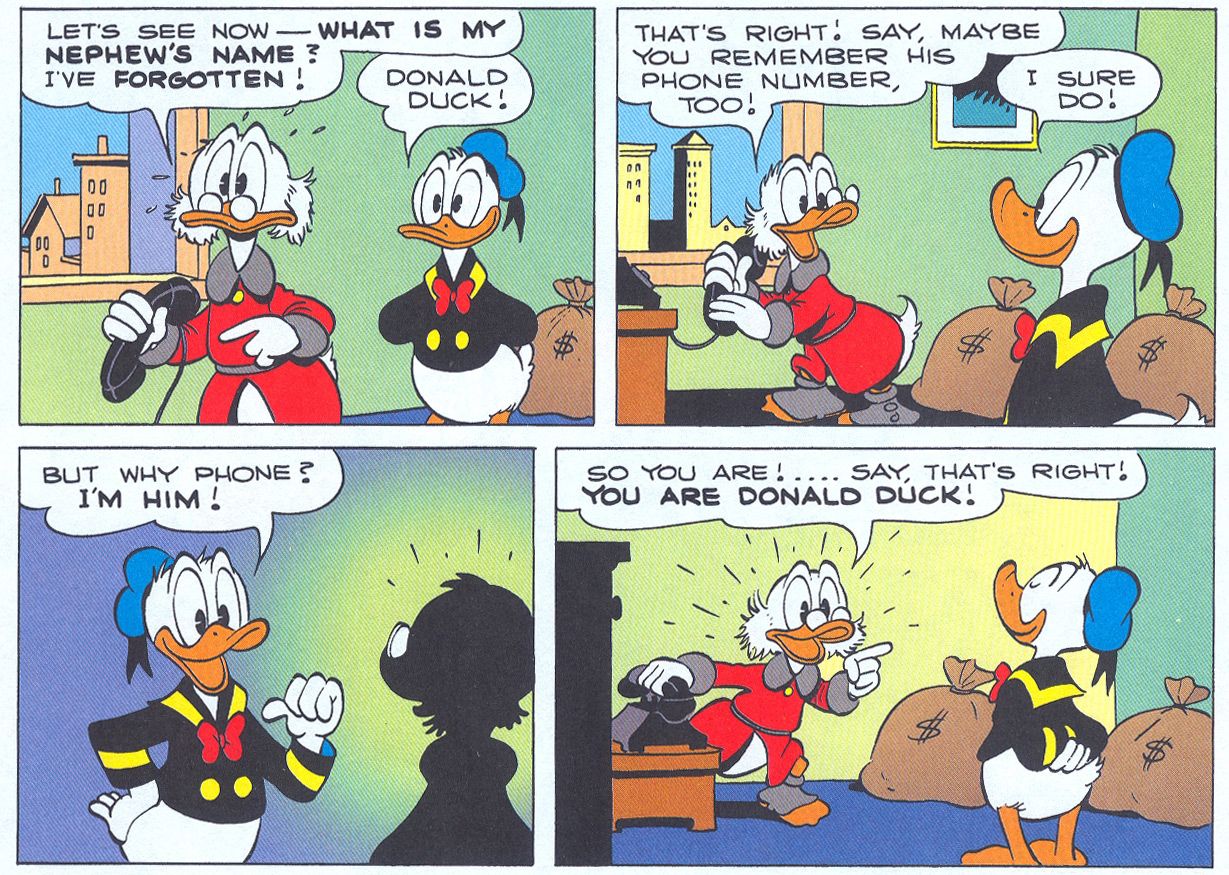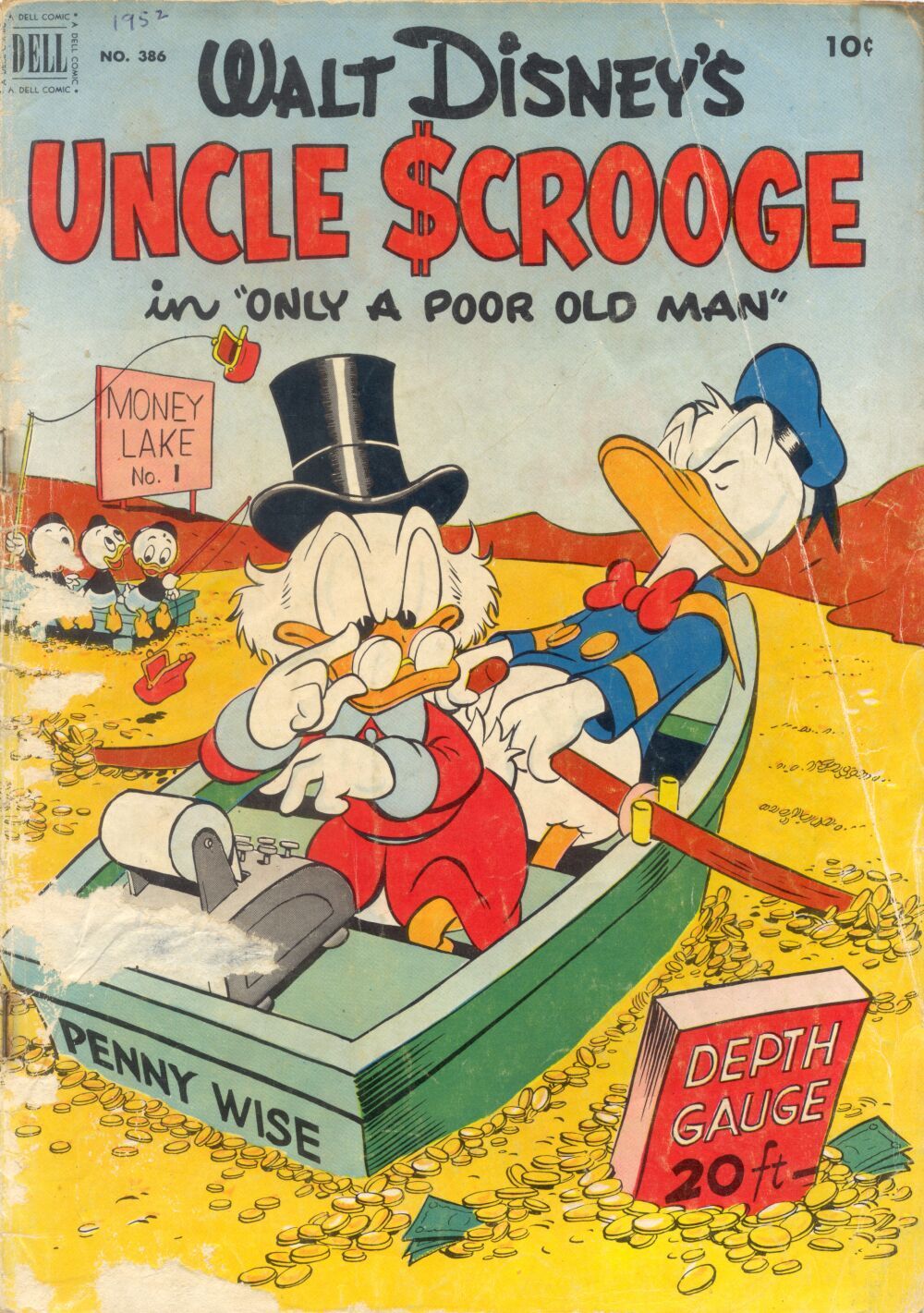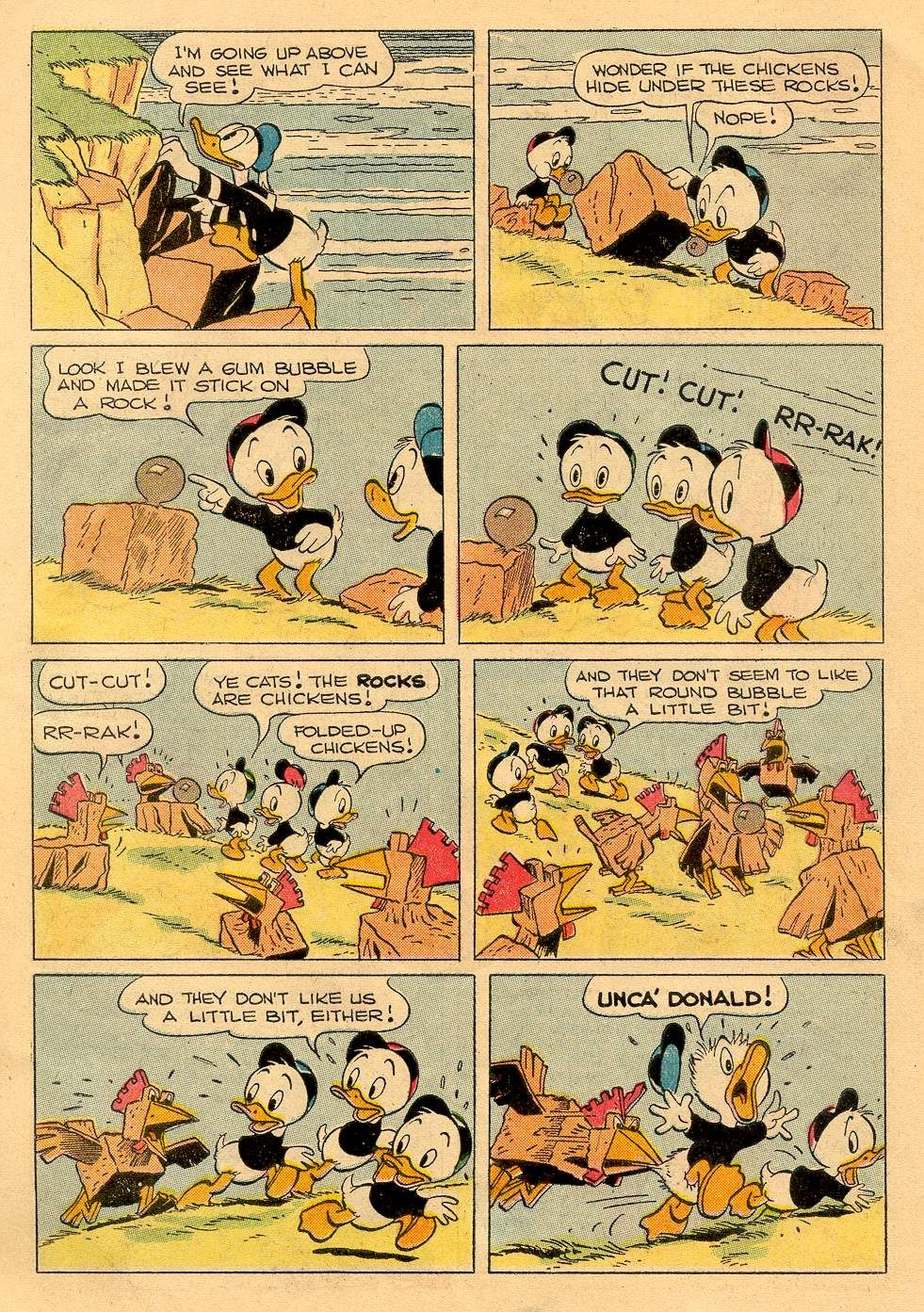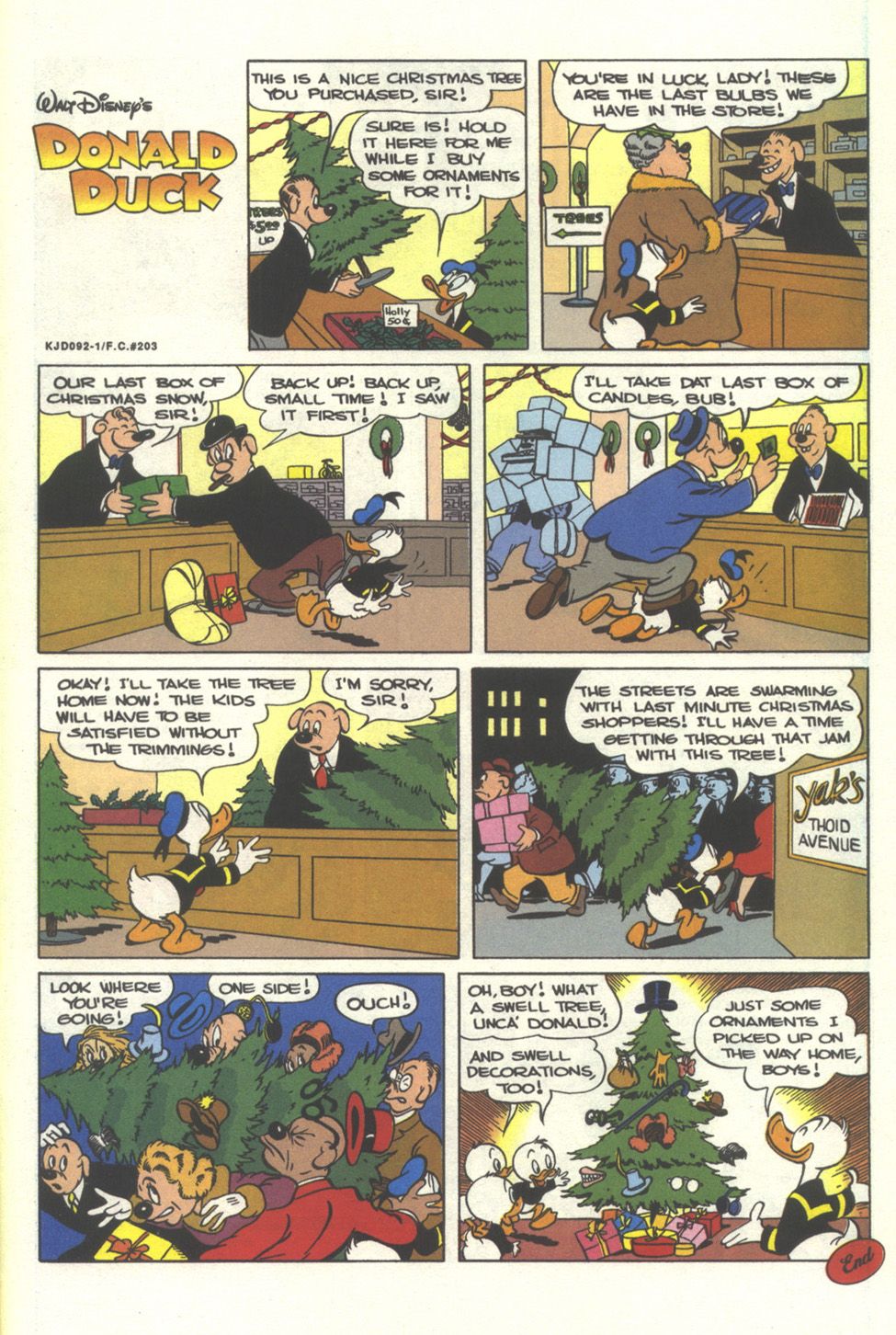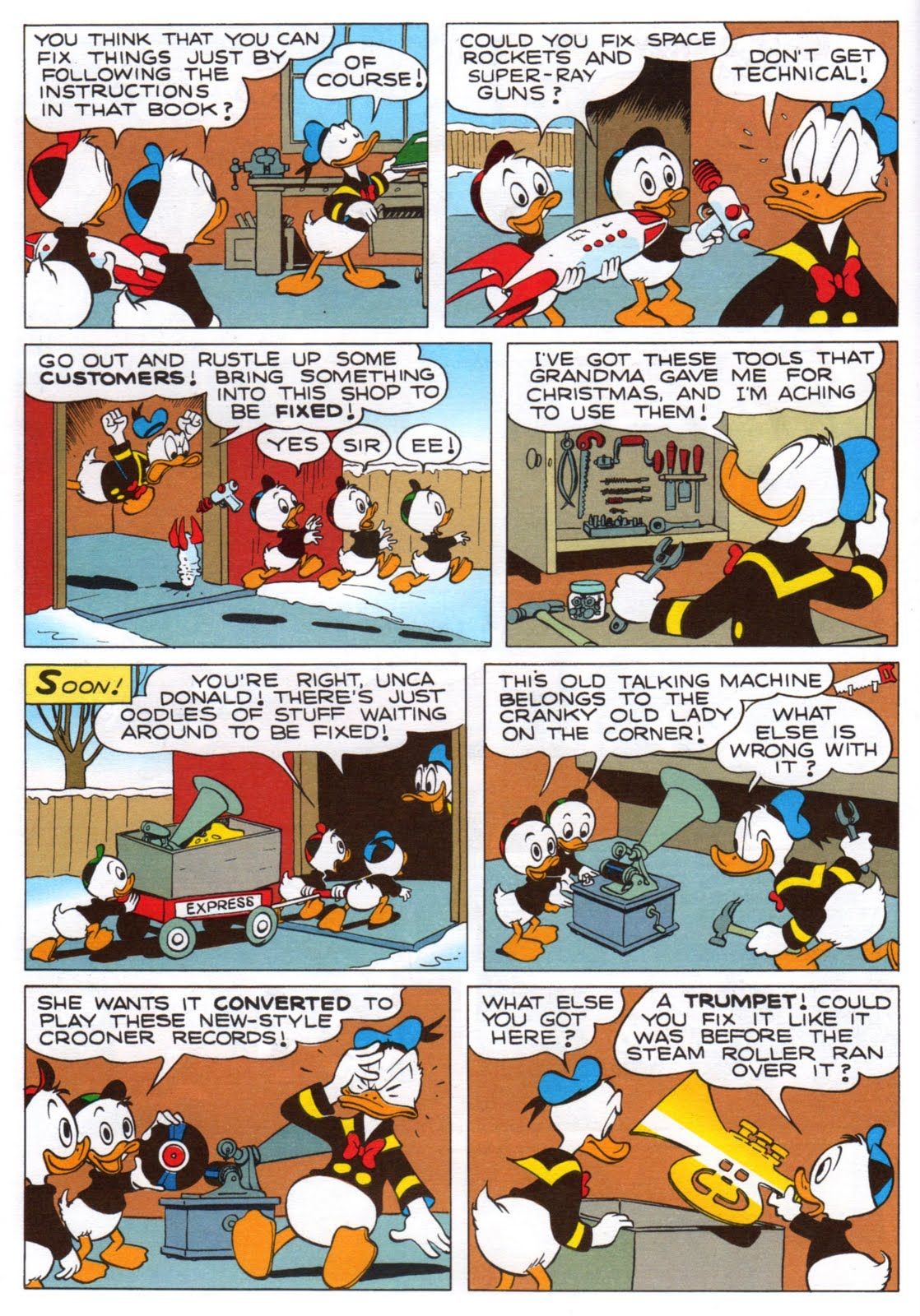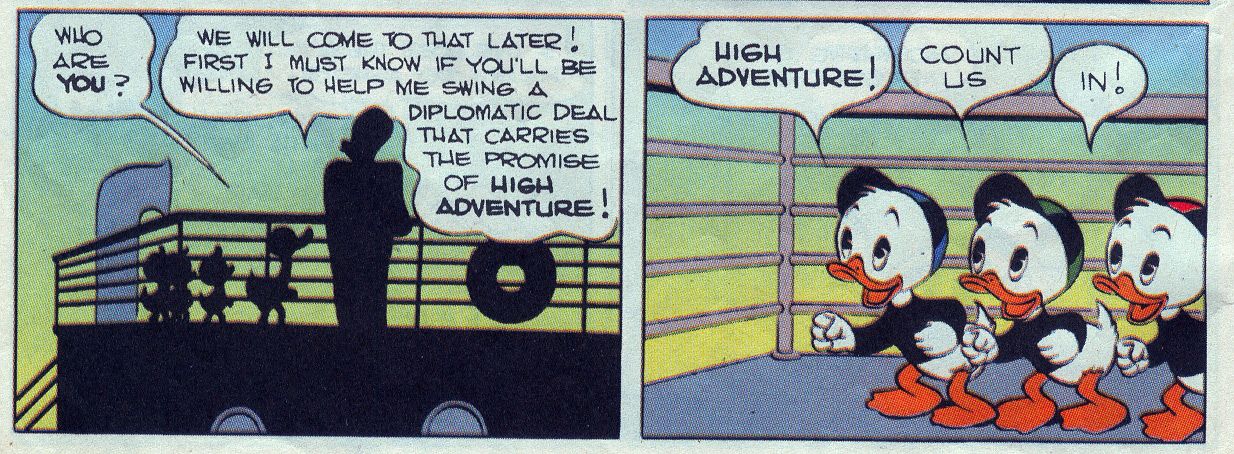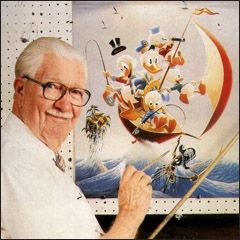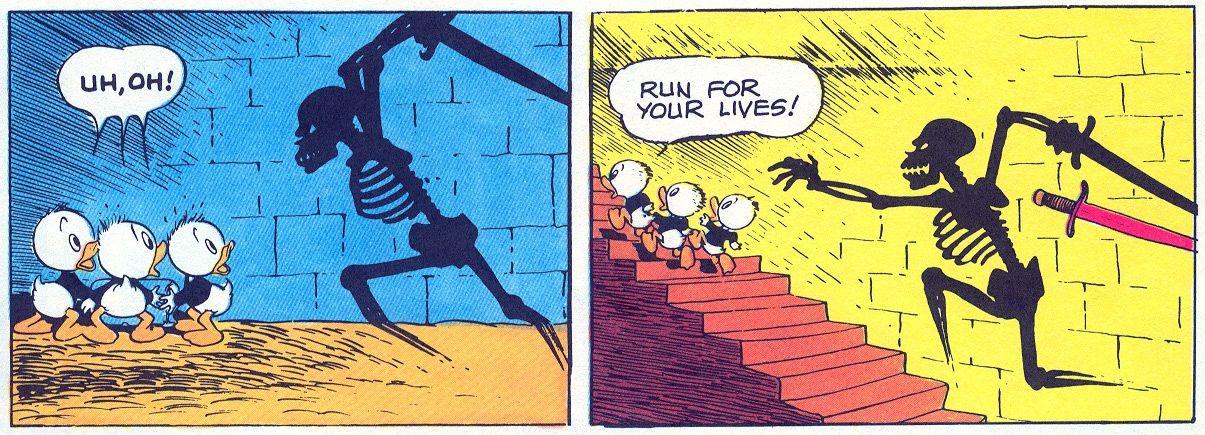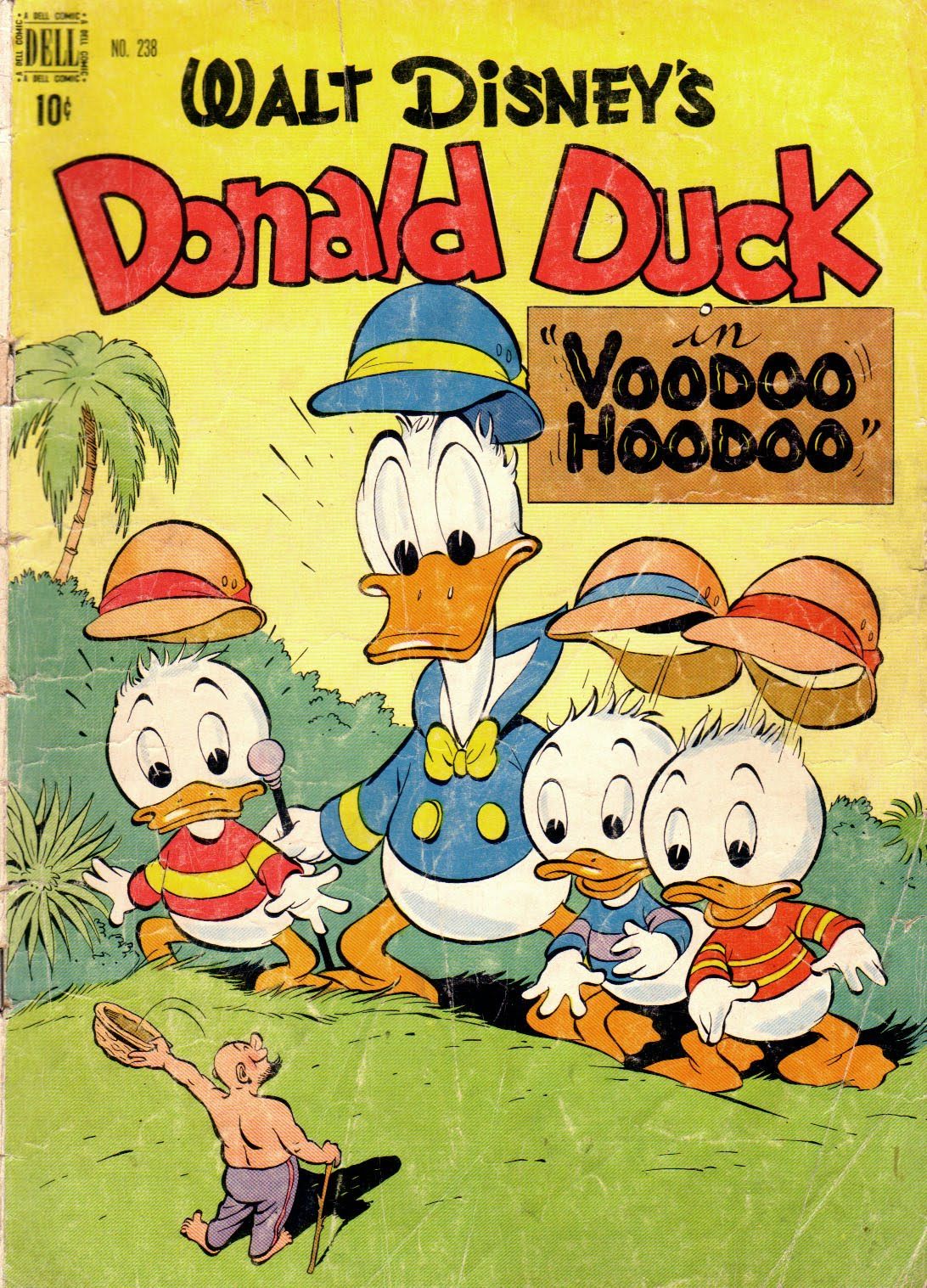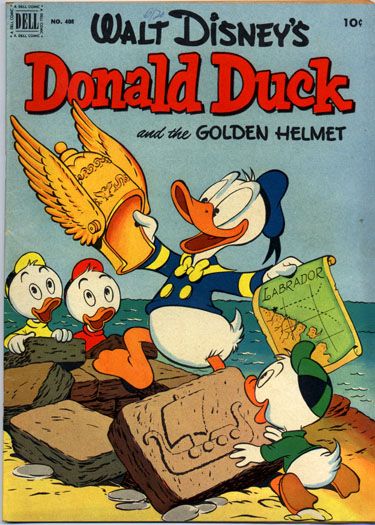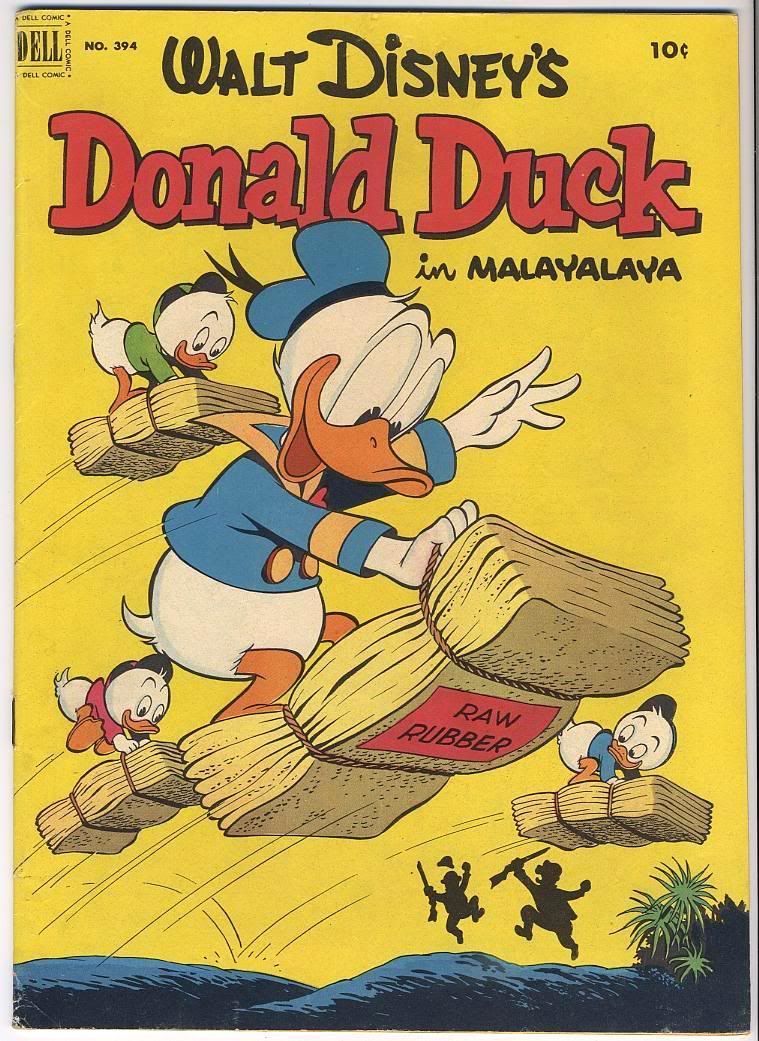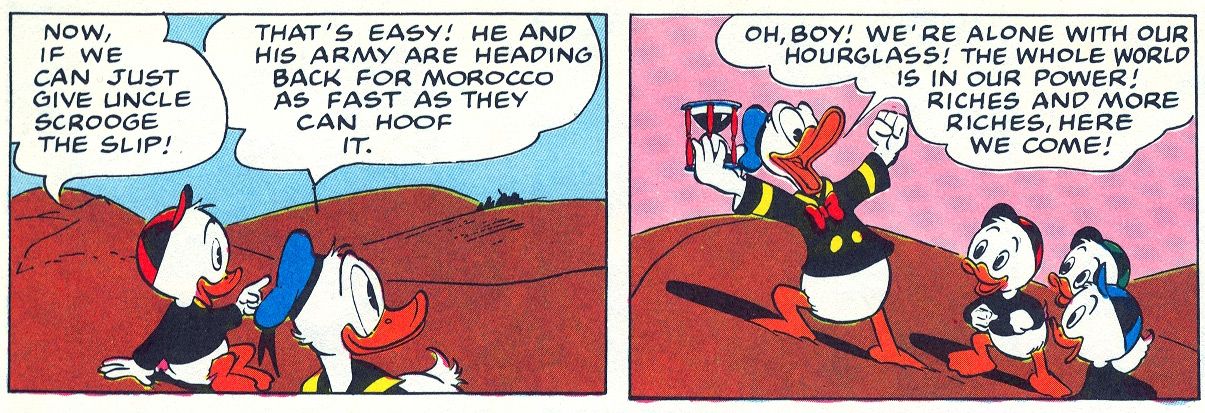In what is sure to be one of the most acclaimed comics events of 2011, Fantagraphics has announced that they will be publishing a definitive collection of Carl Barks’ seminal run of Donald Duck comic stories. In an exclusive interview with Robot 6, Fantagraphics co-publisher Gary Groth revealed that the company – which announced their plans to publish Floyd Gottfredson’s Mickey Mouse comics last summer – had acquired the rights to reprint Barks’ work from Disney and that the first volume will be released in fall of this year. The comics will be published in hardcover volumes, with two volumes coming out every year, at a price of about $25 per volume.
Although the stories will be printed in chronological order, the first volume, “Lost in the Andes,” will cover the beginning of Barks’ “peak” period, circa about 1948. The second volume, “Only a Poor Old Man,” will cover roughly the years 1952-54 and feature the first Uncle Scrooge story. Later volumes will fill in the missing gaps, including his earlier work, in a process somewhat similar to Fantagraphics’ publication of George Herriman’s "Krazy Kat."
For those who aren’t familiar with the name, the Barks library has been one of the great missing links in a time that many have dubbed the “golden age of reprints.” Acclaimed around the globe for his rich storytelling and characterization, as well as excellent craftsmanship, Barks has long been regarded as one of the great cartoonists of the 20th century, equal to luminaries like Charles Schulz, Robert Crumb and Harvey Kurtzman. He's been one of the few major American cartoonists whose work has, up till now, not been collected in a comprehensive, manner respectful of his talent (at least not in North America), however, so this announcement comes as extremely good news for any who read and love good comics, let alone are familiar with Barks' work.
Fantagraphics will release an official announcement about the project tomorrow. In the meantime, click on the link to read our exclusive interview with Gary Groth:
Q: For readers who are not familiar with Carl Barks, can you provide a brief description of who he was and why he’s so significant? What is his influence and importance as an artist?
A: Sure. He was certainly among the greatest comic book artists of the 20th century. He’s one of the few cartoonists who transcended the commercial parameters of those who worked in the comic book industry from its beginning in the late 30s through the end of the century. I can only think of a few other ones who truly transcended that commercial arena -- John Stanley, Harvey Kurtzman, Bernie Krigstein -- but I think Barks did it the most successfully of all of them.
He started working for Disney in the late ‘30s as an in-betweener in their animation department. And he started drawing comics in 1942 almost by accident. He moved from being an in-betweener to being a gag man and they needed someone to help co-draw a Donald Duck comic, which he did and then he quit the Disney animation studio and needed work because his only source of income at that time was a chicken farm. So he asked Western Publishing if he could do some Duck stories and they apparently needed someone to do some new Duck stories and they gave him the assignment.
So he drew Donald Duck from 1942 to approximately 1966. Over that time he became one of the greatest cartoonists of the 20th century. Not only could he draw beautifully and tell a story, but also he invested the duck characters with such depth and humanity and warmth, that it was just an amazing feat. That I think was his real contribution that he gave the Duck characters – he combined imagination and invention and humanity to his stories that no one drawing corporate characters had ever done.
Q: What do you think made him so unique as an artist as opposed to many of the other people working in Disney comics at the time? The amazing thing about Barks to me is the sheer amount of love that’s generated for him by fans. Even compared to some of the people you’ve mentioned. Harvey Kurtzman has his fans, but especially overseas, the sheer amount of papers, essays and web sites devoted to Barks would be surprising to someone who might be coming to him cold.
A: Right. Well, he’s much better known and beloved than he is here. Over here it’s more the specialist and the cognoscenti who are aware of him. Over there he sells and is more appreciated by a larger and wider readership. Which of course we’re hoping to expand to the U.S.
Q: Why do you think that is, that he hasn’t generated as much attention here?
A: Part of it might just be because of the general indifference or contempt with which comics are seen in this country, or at least were seen throughout most of his career. That’s obviously started to change in the last decade or so but Barks missed that window of opportunity. He died in 2000, the same year as Charles Schulz and Gil Kane. He was 99 when he died so his career literally spans the entire 20th century. He was born in 1901.
I have no idea why they appreciate cartoonists and comics more over there than they do here. I wish I knew.
Q: This is a pretty huge feather in your cap. This is one of the big gets.
A: Yeah, I think it’s right up there with Charles Schulz. I think he’s as great a cartoonist as Schulz is, and maybe George Herriman. So yeah, it’s a dream come true. It’s something I hadn’t thought was even possible until a couple of years ago.
Q: How did this come about then?
A: It’s pretty simple. Gemstone, which was Diamond’s publishing arm, was evidentially contracted to publish a lot of Barks material and had published Barks throughout the years, but in various formats that I don’t think made much of an impression.
When Gemstone went out of business about three years ago, being the opportunist I am I saw a possibility. I got hold of Disney and that’s where we also cut the deal for Gottfredson. It was the same impetus -- I saw that they had lost a publisher and I thought it would be perfect for us for all the obvious reasons. I’ve loved Barks’ work since I was a teen-ager and discovered him. I thought we could do the right job. I’ve always lamented what lousy job publishers have done with Carl Barks. I like the Another Rainbow editions, but they are purely collector editions made for guys like you and me. What I want to do is publish books that will find a general readership, because he deserves one. He deserves as wide a readership as possible. He’s accessible enough. He’s not one of those arcane, obscure cartoonists that the general public wouldn’t understand. His stuff can be read by children or adults, it can be understood on different levels. One of my goals is to publish it in a format that will reach that wider readership. I’m hoping parents buy it, read it themselves and also give it to their kids to read.
To tie up that story, I contacted Disney and it took a couple of years to agree to a publishing contract. At first they told me they were going to publish it themselves, and I tried to talk them out of that without initial success. And then literally like a year later they called me back and said, “we decided not to publish it ourselves and that you’d be the right people to do it.”
Q: What has it been like working with Disney? Do they have a strong appreciation for Barks?
A: Yes, I think they do. At least the people I’m working with do. Now obviously the people I’m working with have highers-up who may not fully understand or appreciate who Barks was, but all the people I’m working with at Disney do. They’re well versed in Barks and understand his significance in the comics pantheon. The hardest thing I had to do was find somebody at Disney to talk to. That literally took me about a year. Once I did that it was pretty smooth sailing. I’ve been working with them pretty closely, I’ve been submitting proposals and formats and content and I have to say everything’s gone really, really smoothly. I’m hoping for the best.
Q: Let’s go on to the books themselves. Can you tell me a little bit about the format, size and design? Who will be designing these books?
A: I think Jacob Covey is going to be designing them. He’s our lead designer here. In fact literally at this very moment he’s designing "Mickey Mouse Vol. 1." He’s designed a number of books for us, as you probably already know, like "Popeye" and "Dennis the Menace." He edited and designed “Beasts!” So he was my first choice to design the books.
They’re going to be reproduced – I don’t have the exact size – but they’re going to be reproduced at about 90 percent of comic book size. I don’t have that size off the top of my head, but it’s approximately 90-92 percent of comic book size. We are going to be recoloring every page. We’re using the original comics as our color guide. We’re going to be trying as best we can to reproduce the same colors. The reason we didn’t scan the comic books is we didn’t want it to be a facsimile edition like some of our reprints are. When you do that, it’s obvious that you are reproducing from the comic and there is a specific reason you do that, because you want to capture that old comic book look. Neither Disney nor we wanted to do that, but we both thought it would be best reproduced in color, so the question was how do you go about doing the color? So we’re using the original comics coloring, which is quite good, as a color guide, and an artist by the name of Rich Tommaso is going to be recoloring every page.
Q: That’s interesting because I was going to ask you if you were going to be using the European collections as a guide because I know some of the recoloring for those books came under controversy because they were very Photoshop-heavy.
A: Personally, I can’t stand that kind of recoloring, where it looks like what used to be called airbrushed, with the gradations of tone and the sculpting and modeling and so forth. To me, that’s a betrayal of how they were originally published and how Barks drew them for reproduction. So we’re going to go with flat colors, but they’re going to be somewhat muted. What we’re trying to do is to reproduce as best we can not only the color scheme, but the chromatic intensity of the colors, so they’re not going to be bright and garish. We’re going to reproduce them on an uncoated stock. It’s obviously going to be heavier than the newsprint they were published on, but it’s going to be uncoated so it will be a very muted stock and the colors will be – they won’t pop off the page like they would with a glossy approach. The colors will be secondary to the actual art.
Q: How much will the individual volumes sell for?
A: I think the retail price is $24.99. They will be hardcover. They will be approximately 240 pages per volume, with a good 200 of those being comics and the rest being some text material -- supportive, historical and aesthetic appreciations.
One important fact is that we’re starting with the material he did in 1948, so the first volume is going to be titled “Lost in the Andes.” Now, you know Barks’ work, right?
Q: I’m not as familiar as you obviously are. I’ve read his work but you tend to read him if you’re an American in dribs and drabs. So I have a couple volumes of this and that but I wouldn’t call myself an expert by any means.
A: OK. Well then let me explain. He started doing Donald Duck in 1942. He did it through ’66. I think his peak period was somewhere from ’47 or ’48 and ’56. That’s my opinion and there’s a reasonable consensus among Barks experts – by no means a 100 percent consensus -- but that’s generally perceived as his peak period. The first Uncle Scrooge story appeared in 1952. And he was just really cooking at that point. He had learned how to do comics. There was a bit of a learning curve although he was good from the get go. He just mastered narrative. He mastered how to incorporate gags into a narrative. He invested more and more of himself into the work. I think part of the reason the work is so good is because he lived a life before he started drawing the ducks. He started drawing the ducks when he was about 40. By then he was a lumberjack, he worked in a lumber mill, he worked on a riveting gang, he worked on a ranch, a farm. He just did a lot of life experience. From which he got a lot of material for the adventures he wrote.
So we’re going to start with 1948, the first volume will be called “Lost in the Andes.” It will have that titled strip in it. We’re going to mess around a little bit. I think the second volume is going to be titled “Poor Old Man,” which is the first Uncle Scrooge story. That will be 1952 to about 1954.
What I’ve done is I have mapped out the entire Barks collection chronologically. Eventually when we publish however many volumes it will be, which could be – let’s see, he did 6,000 pages – it will be almost 30 volumes of books. Eventually once we publish all of those, someone will be able to put every book in chronological order on a shelf. We’re starting with what will be the seventh volume in the series. It will be our first published volume. I know that will be a little confusing, but our first published volume will actually be the seventh volume in the series.
Q: So you’re not starting with the very first Barks comics, you’re starting a little later?
A: Exactly. The first one was in 1942. The first story was called “Donald Duck Finds Pirate Gold.”
Q: Now what was the thinking behind that decision?
A: Well, I wanted to start off with the best stuff. That’s primarily it; I wanted to hook people on the best Barks. “Lost in the Andes” I think, is one of his best stories. It’s an iconic story. Among people who know Barks it’s their favorite.
Q: Is that the one with the square eggs?
A: Exactly. This is a slightly sentimental point, and it didn’t hinge on this, but it was also Barks’ favorite story, so I thought that was a nice gesture. It also just happens to be one of the best stories he did. And as you probably know he did the long stories that appeared in “Four Color Comics.” They were usually between 20 and 32 pages in length, and then he did the 10 pagers that appeared in “Walt Disney Comics and Stories.” So each volume will contain some of both.
Q: I was going to ask about that, because he did work over so many different titles, how you were going to accommodate that, if you were going to do one series first and then put the others out.
A: No, we’re doing it strictly chronologically. So this volume will contain two of the long stories and the rest of them will be the 10 pagers. It includes “Voodoo Hoodoo,” “Race to the South Seas” and “The Golden Christmas Tree,” which are all long stories. They’re all between 20 and 32 pages and the rest will all be 10 page stories.
My original thought was to do the 30 volumes and have a lead story that was a long story in each one and then fill the rest of the book up with shorter pieces. I actually consulted with five Barks scholars throughout the world because I couldn’t quite figure out if I used that as a template -- if I used the longer stories as an anchor for the books -- I couldn’t figure out how to organize everything else, how to choose stories that would then fill them. You couldn’t do it chronologically because he stopped doing the long stories sometime in the ‘50s. There was a period where he did a lot of long stories in, like, two years, so I couldn’t figure out how to do that and I was finally convinced that I should just do it chronologically, which made my job a lot easier.
Q: What kind of historical information will you be including in the volumes?
A: Well, I don’t want to have too much text in each volume. There’s going to be a biography of Barks that I might rerun in every volume. And then I’m going to get three or four separate pieces that just discuss the particular stories that are in each volume and give a little historical context to the stories. So there will be between three and five text pieces looking at the stories from various angles, maybe sociological, maybe aesthetic. Not so much that it overwhelms the reader but enough to give them context as to what these things are and who Carl Barks is and why they’re as good as they are.
Q: Do you have anyone lined up so far? Any names you can name?
A: The only person I have really lined up is Donald Ault, who’s going to be writing the biography of Barks. Don edited a book called “Conversations with Carl Barks” that University Press of Mississippi published a couple of years ago. He’s been a Barks fan and admirer for quite a few years – 30 or 40 years. He really knows his stuff. He knows more than I do and he’s one of the people I’ve been consulting on this. He’s really very good and knows and loves Barks and is a good writer so he’ll be doing the biography.
Q: What about in terms of ancillary art material? Sometimes in these collections they’ll publish sketchbook material or other unpublished art.
A: I haven’t gotten quite far enough to know for sure but my impression is if the rights are clear, which I think that they are because I think everything is owned by Disney (which makes my job easier) I think we’ll probably be including a lot of photographs and sketches, model sheets he did and things like that. So there will be a lot of miscellaneous stuff will be included with the text. We’re aiming this for a general readership, so I don’t want this to get too wordy.
Q: Along those lines, let me ask in terms of marketing and promotion, how are you planning on reaching that ideal readership? What are your plans? Is there anything you’re doing that might be noteworthy or different from how you’ve promoted your other reprint projects?
A: You know, those are great questions, but they’re great questions for Eric [Reynolds]. He and I and Disney have been exchanging emails about this but frankly I haven’t been paying that close attention to it. My main job has been to get the editorial down. So it would be best if I didn’t give you some half-assed answer about that. We’re hoping to get into Disney stores and Disney theme parks and all that. They have a very systematic grasp of where that is in the process right now.
Q: What’s the schedule for this? How many volumes do you plan to release in a year?
A: Two a year. The first one will be October or November of this year. Just in time for Christmas.
Q: And then it will be one in the spring and one in the fall?
A: Exactly. Two a year from then on, just like Peanuts and Mickey. Mickey, Charlie and Donald.
Q: The mighty triumvirate.
A: Yeah, right. I discovered Barks when I was 16. I was already deeply into comics and then a friend of mine turned me on to it and I kind of flipped out, started buying every back issue of Barks I could find and read them into my 20s and probably had 2/3rds of Barks, but at some point you stop reading him and you move on cause there’s so much else to read. So for the past few months I’ve been re-reading him. I’ve probably re-read about 700 or 800 pages of Barks in the last few months. It’s just amazing.
Q: The thought occurred to me that most young people aren’t aware of Donald Duck because he’s not as prominent a Disney character any more as Belle or the Little Mermaid are for modern generations. And beyond that you’ve got the issue of trying to convince parents and adults that these children’s stories about ducks in sailor suits are some of the greatest comics around. Do you feel like you have a lot of convincing to do?
A: I have to say I hadn’t thought of it from that angle. I guess not. There’s a sense in which we do because we’re dealing with two things that are a bit of a hard sell, comics and print. (laughter) Luckily we’re not Random House, we don’t have to sell 300,000 copies either. For us, I think we’ll sell quite a lot of copies but however many copies we sell constitute a mass market these days I’m not sure. In a sense sure, we have to convince people, but that’s our job. To some extent that was even true of Peanuts. The strip itself had become such a tiny proportion of its worldwide sales after merchandising, it was almost as if we had to reacquaint people with the strip.
So I don’t know. I guess there are probably a sufficient number of people of a certain generation who remember Donald Duck as a cartoon character or comic character that they’re going to be picking it up. I hope they’ll pass it on to their kids.

